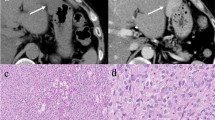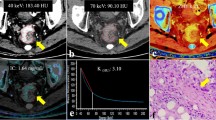Abstract
Background
Indocyanine green (ICG) and carbon nanoparticle (CN) have been widely used for radical gastrectomy. However, synchronous application of ICG and CN in gastrectomy has not been tried yet. For the first time, we herein reported a novel strategy using dual tracers in laparoscopic radical gastrectomy.
Methods
This is a single-center, single-armed, prospective study. For each qualified patient, submucosal CN was injected the day before surgery, and subserosal ICG was injected immediately before surgery. Standard D2 laparoscopic gastrectomy and lymph node examination were subsequently performed. Demographics, lymph nodes (LNs) and postoperative outcome were collected for analysis. To analyze the safety and efficacy of this novel strategy, two contemporary historic control groups using single tracer were established.
Results
A total of 60 patients underwent dual tracer laparoscopic gastrectomy and were divided into distal (n = 41) and total (n = 19) groups. An average of 53.3 and 62.2 LNs was harvested from two groups, respectively. The average operation duration was 213.3 and 250.0 min, and intra-operative blood loss was 100.2 ml and 94.7 ml. None received combined organ resection. Margin negativity and R0 resection were achieved in all patients. Three (7.3%) complications occurred in distal group. None required second operation or deceased. Postoperative hospitalization was 9.7 and 9.6 days, respectively. Compared to single tracer, more LNs (p < 0.01), shorter operation time (p < 0.01), less blood lost (p < 0.01) and accelerated postoperative recovery (p < 0.01) were observed in dual tracer group.
Conclusions
We propose a novel, feasible and safe tracing strategy for laparoscopic gastrectomy.
Clinical Trial Registration
Chinese Clinical Trial Registry (ChiCTR2100051309).



Similar content being viewed by others
Data Availability
All raw data is available from the corresponding author upon reasonable request.
References
Wong MCS, Huang J, Chan PSF, et al. Global incidence and mortality of gastric cancer, 1980-2018. JAMA Netw Open. 2021; 4(7): e2118457.
Mocellin S. The effect of lymph node dissection on the survival of patients with operable gastric carcinoma. JAMA Oncol. 2016; 2(10): 1363-1364.
Sasako M, Sano T, Yamamoto S, et al. D2 lymphadenectomy alone or with para-aortic nodal dissection for gastric cancer. N Engl J Med. 2008; 359(5): 453-462.
Kim YW, Min JS, Yoon HM, et al. Laparoscopic sentinel node navigation surgery for stomach preservation in patients with early gastric cancer: a randomized clinical trial. J Clin Oncol. 2022: JCO2102242.
Lu X, Liu S, Xia X, et al. The short-term and long-term outcomes of indocyanine green tracer-guided laparoscopic radical gastrectomy in patients with gastric cancer. World J Surg Oncol. 2021; 19(1): 271.
Chen QY, Xie JW, Zhong Q, et al. Safety and efficacy of indocyanine green tracer-guided lymph node dissection during laparoscopic radical gastrectomy in patients with gastric cancer: a randomized clinical trial. JAMA Surg. 2020; 155(4): 300-311.
Tian Y, Yang P, Lin Y, et al. Assessment of carbon nanoparticle suspension lymphography-guided distal gastrectomy for gastric cancer. JAMA Netw Open. 2022; 5(4): e227739.
Li Z, Ao S, Bu Z, et al. Clinical study of harvesting lymph nodes with carbon nanoparticles in advanced gastric cancer: a prospective randomized trial. World J Surg Oncol. 2016; 14: 88.
Huang ZN, Su-Yan, Qiu WW, et al. Assessment of indocyanine green tracer-guided lymphadenectomy in laparoscopic gastrectomy after neoadjuvant chemotherapy for locally advanced gastric cancer: results from a multicenter analysis based on propensity matching. Gastric Cancer. 2021; 24(6): 1355–1364.
Wang FH, Zhang XT, Li YF, et al. The Chinese Society of Clinical Oncology (CSCO): Clinical guidelines for the diagnosis and treatment of gastric cancer, 2021. Cancer Commun. 2021; 41(8): 747-795.
Japanese Gastric Cancer Association. Japanese Gastric Cancer Treatment Guidelines 2021 (6th edition). Gastric Cancer. 2023; 26(1): 1–25.
Gastric Cancer Professional Committee, Chinese Anticancer Association; Oncogastroenterology Professional Committee, Chinese Anticancer Association. Chinese experts consensus on standardized surgical management of specimens from radical gastrectomy (2022 edition). Zhonghua Wei Chang Wai Ke Za Zhi. 2022; 25(2): 93–103.
Chen Y, Liu G, Wu Y, et al. Assessment of liver injury using indocyanine green fluorescence imaging. Ann Transl Med. 2021; 9(14): 1167.
Agha R, Abdall-Razak A, Crossley E, et al. The STROCSS 2019 Guideline: Strengthening the Reporting of Cohort Studies in Surgery. Int J Surg. 2019; 72: 156-165.
Gholami S, Janson L, Worhunsky DJ, et al. Number of Lymph Nodes Removed and Survival after Gastric Cancer Resection: An Analysis from the US Gastric Cancer Collaborative. J Am Coll Surg. 2015; 221(2): 291-299.
Macalindong SS, Kim KH, Nam BH, et al. Effect of total number of harvested lymph nodes on survival outcomes after curative resection for gastric adenocarcinoma: findings from an eastern high-volume gastric cancer center. BMC Cancer. 2018; 18(1): 73.
Lu J, Wang W, Zheng CH, et al. Influence of Total Lymph Node Count on Staging and Survival After Gastrectomy for Gastric Cancer: An Analysis From a Two-Institution Database in China. Ann Surg Oncol. 2017; 24(2): 486-493.
Shen Z, Ye Y, Xie Q, et al. Effect of the number of lymph nodes harvested on the long-term survival of gastric cancer patients according to tumor stage and location: a 12-year study of 1,637 cases. Am J Surg. 2015; 210(3): 431-440.
Ushimaru Y, Omori T, Fujiwara Y, et al. The feasibility and safety of preoperative fluorescence marking with indocyanine green (ICG) in laparoscopic gastrectomy for gastric cancer. J Gastrointest Surg. 2019; 23(3): 468-476.
Kim TH, Kong SH, Park JH, et al. Assessment of the completeness of lymph node dissection using near-infrared imaging with indocyanine green in laparoscopic gastrectomy for gastric cancer. J Gastric Cancer. 2018; 18(2): 161-171.
Herrera-Almario G, Patane M, Sarkaria I, et al. Initial report of near-infrared fluorescence imaging as an intraoperative adjunct for lymph node harvesting during robot-assisted laparoscopic gastrectomy. J Surg Oncol. 2016; 113(7): 768-770.
Chen QY, Zhong Q, Li P, et al. Comparison of submucosal and subserosal approaches toward optimized indocyanine green tracer-guided laparoscopic lymphadenectomy for patients with gastric cancer (FUGES-019): a randomized controlled trial. BMC Med. 2021; 19(1): 276.
Zhong Q, Chen QY, Huang XB, et al. Clinical implications of indocyanine green fluorescence imaging-guided laparoscopic lymphadenectomy for patients with gastric cancer: a cohort study from two randomized, controlled trials using individual patient data. Int J Surg. 2021; 94: 106120.
Baiocchi GL, Molfino S, Molteni B, et al. Fluorescence-guided lymphadenectomy in gastric cancer: a prospective western series. Updates Surg. 2020; 72(3): 761-772.
Yan J, Zheng X, Liu Z, et al. A multicenter study of using carbon nanoparticles to show sentinel lymph nodes in early gastric cancer. Surg Endosc. 2016; 30(4): 1294-1300.
Chen H, Wang Y, Xue F, et al. Application of subserosal injection of carbon nanoparticles via infusion needle to label lymph nodes in laparoscopic radical gastrectomy. Zhonghua Wei Chang Wai Ke Za Zhi. 2014; 17(5): 457-460.
Tian Y, Lin Y, Guo H, et al. Safety and efficacy of carbon nanoparticle suspension injection and indocyanine green tracer-guided lymph node dissection during robotic distal gastrectomy in patients with gastric cancer. Surg Endosc. 2022; 36(5): 3209-3216.
Lu X, Liu S, Ai S, et al. Comparative study of carbon nanoparticles and indocyanine green-guided lymphadenectomy during laparoscopic radical gastrectomy. Zhonghua Pu Wai Ke Shou Shu Xue Za Zhi. 2021; 15(2): 146-149.
Amin MB, Edge S, Greene F, et al. (Eds.). AJCC Cancer Staging Manual (8th edition). Springer International Publishing: American Joint Commission on Cancer; 2017.
Chen X, Chen Y, Hu Y, et al. The methods of lymph node examination make a difference to node staging and detection of N3b node status for gastric cancer. Front Oncol. 2020; 10: 123.
Acknowledgements
This work was supported by the National Natural Science Foundation of China (82172645), Natural Science Foundation of Jiangsu Province for Outstanding Young Scholars (BK20200052), Jiangsu Provincial Key Research and Development Program (BE2022667 and BE2022753), Key Project of Nanjing Health Commission (ZKX21013), Bethune Charitable Foundation (05002), and Clinical Trials from the Affiliated Drum Tower Hospital Medical School of Nanjing University (2021-LCYJ-MS-09 and 2021-LCYJ-PY-17).
Author information
Authors and Affiliations
Corresponding author
Ethics declarations
Disclosure
None to declare.
Additional information
Publisher's Note
Springer Nature remains neutral with regard to jurisdictional claims in published maps and institutional affiliations.
Supplementary Information
Below is the link to the electronic supplementary material.
Supplementary Video 1 Lymph node examination using fluorescence examination system (Real-IGS FLI-10B) after gastrectomy. (MP4 65176 KB)
Rights and permissions
Springer Nature or its licensor (e.g. a society or other partner) holds exclusive rights to this article under a publishing agreement with the author(s) or other rightsholder(s); author self-archiving of the accepted manuscript version of this article is solely governed by the terms of such publishing agreement and applicable law.
About this article
Cite this article
Liu, S., Ai, S., Song, P. et al. Subserosal Indocyanine Green Plus Submucosal Carbon Nanoparticle Navigated Laparoscopic Gastrectomy (DANCE-01): a Cohort Study. J Gastrointest Surg 27, 2068–2075 (2023). https://doi.org/10.1007/s11605-023-05756-z
Received:
Accepted:
Published:
Issue Date:
DOI: https://doi.org/10.1007/s11605-023-05756-z




